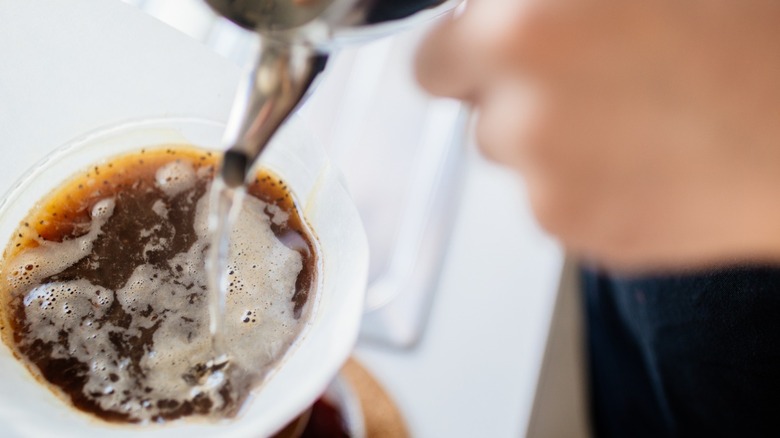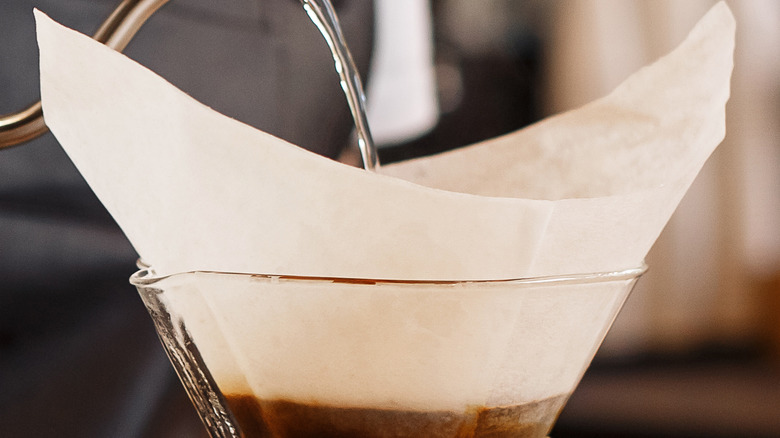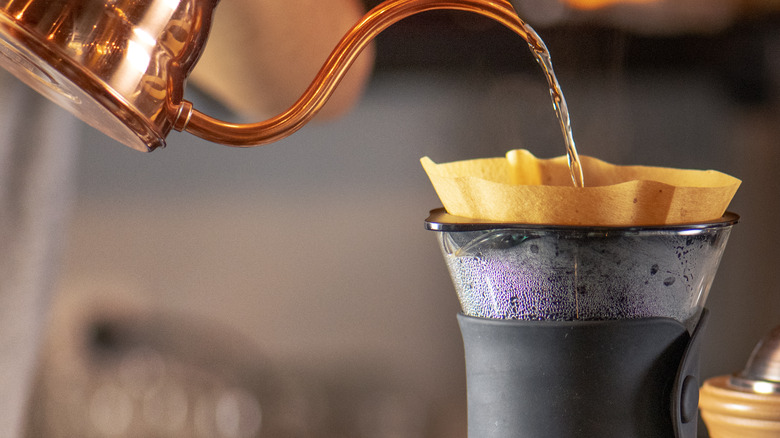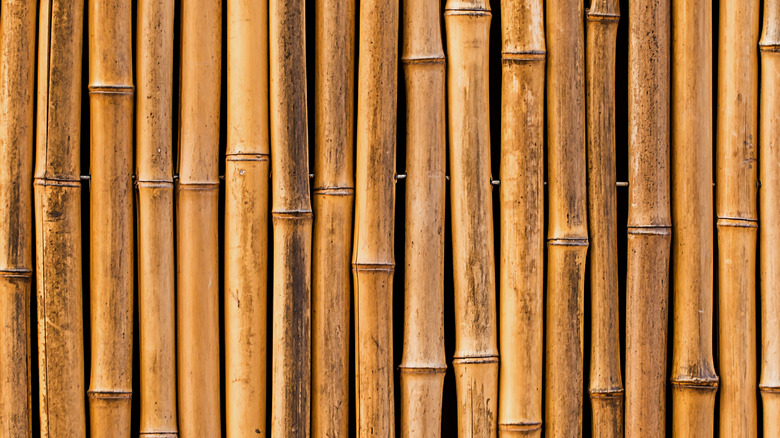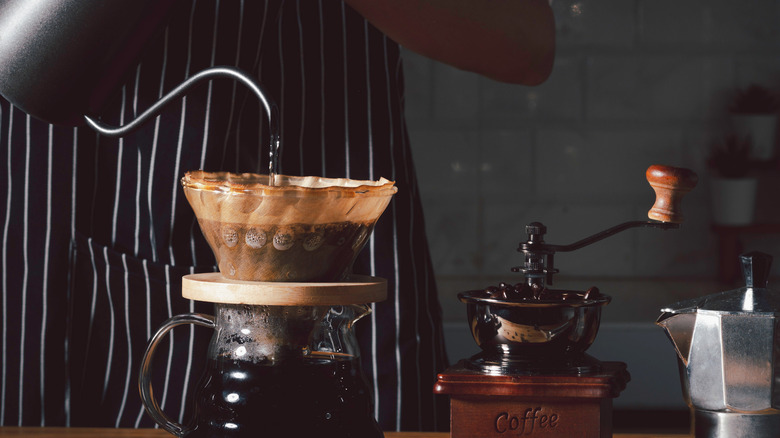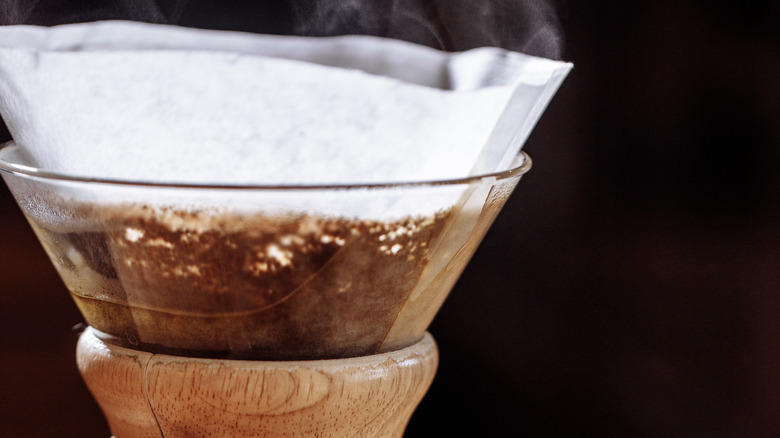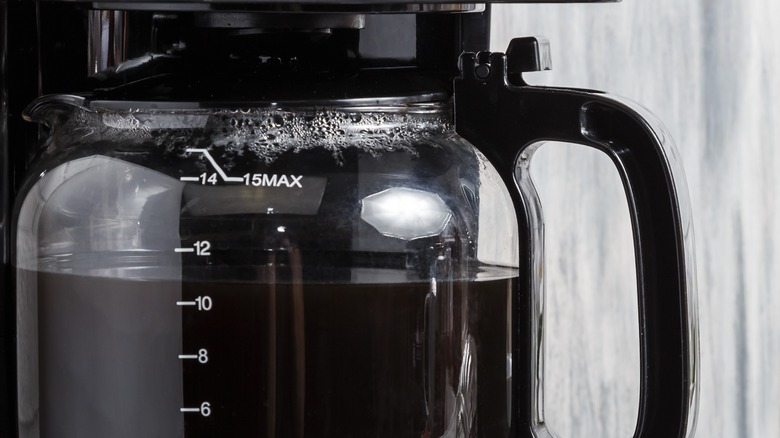13 Types Of Coffee Filters And How To Use Them
Most coffee lovers obsess over the beans they use for their morning brew, but don't think twice about their coffee filters. Did you know the type of filters you use can make a big difference in taste and texture? You can taste dozens of coffee brands spanning different roasts and countries of origin, but until you find the filter that works for you, you probably won't be able to create a truly perfect cup of coffee.
From bamboo to metal, and baskets to cones, the choices for filters are endless. You will not only learn about the different materials, shapes, and sizes of coffee filters, but also how to use each one to create the best drink possible. After all, a lot of filters require special cleaning methods, maintenance, or tricks to get them to work at their best level.
Depending on how clear, bold, or eco-friendly you prefer your cup of joe, there is a perfect filter for you out there.
Bleached paper filters
The white paper coffee filters you see in offices around the country are a popular choice for several good reasons. These include relative affordability, easy use, and lack of maintenance. After all, since paper filters are disposable, they don't require any cleaning. The one downside for your brew is that some coffee drinkers believe the filter's material creates the potential for a slightly papery taste.
Though paper filters are a no-fuss option, they are among the least eco-friendly choices because of the trees cut down to make them, how quickly they get used up, and the chemicals used in the bleaching process to convert the paper's natural brown color to white. However, they are a great choice for those who don't have the time to clean up between pours and prefer a very clear cup of coffee, as the paper's tightly woven material and small pores filter out most grounds and excess oils.
To use a bleached paper filter, fill up the water tank, put the filter in the coffee maker's compartment, and pour the grounds directly into the filter. If you end up with leftovers from your pack, all those extra paper filters can come in handy for other tasks around the house.
Unbleached paper filters
Unbleached filters will create a clear cup of coffee lacking grounds and excess oils. However, many coffee drinkers insist that unbleached papers in their natural state leave a more prominent papery taste in their mouths. In order to get rid of this potential taste issue, you can prepare the filter by placing it in the coffee maker, pouring hot water over it, and then getting rid of the water before making your coffee as usual. Wetting the entire filter will limit or even eliminate the transfer of any paper taste to your actual cup of coffee.
The biggest difference between bleached and unbleached paper coffee filters is the color; unbleached filters retain the natural brown hue of the paper. For this reason, unbleached filters are a slightly more environmentally conscious option, as chemicals aren't used to alter their appearance. However, they are still one-use, disposable filters, so they leave a higher carbon footprint than most other multi-use materials.
Bamboo coffee filters
You might not even know that bamboo coffee filters are an option, as they just started becoming popular in the last few years. Bamboo filters allow some more particles to pass through, which maintains more of the drink's natural oils. You can use it in the exact same way as any other paper filter. You may also find that a bamboo filter keeps its conical shape much better than most other paper filters when placed in your coffee maker. This ends up causing less mess and requiring less clean-up, allowing you to get started on your morning cup right away.
Though many consumers might not see the difference between getting filters from trees or bamboo (after all, don't both involve paper made from cutting down plants?), bamboo filters are actually a much more environmentally conscious choice. This is primarily because bamboo is an easily renewable resource thanks to the plant's incredibly rapid growth rate. Plus, you can compost the filters after using them. Just keep in mind that bamboo filters tend to be slightly more expensive than paper filters.
Metal coffee filters
If you prefer fuller, sweeter coffee with a stronger taste, metal filters may be the choice for you. The metal's larger pores allow more natural oils and tiny grounds to drip through, creating a bold flavor as well as a textured cup of coffee. Since metal filters are reusable, you will have to rinse them out every time you use them and occasionally do some deep cleaning to keep them working, as well as avoid any build-up that could affect the taste of your coffee.
Most metal filters are made of either aluminum or stainless steel. One downside of this filter type is that it can leave a bit of a metallic taste in your coffee, no matter the material used. Also, if you prefer very finely ground coffee, metal filters may not be the best choice, as they will let through a lot more of the particles than paper filters.
In order to clean a metal filter after you use it, rinse it out with dish soap and water, then let it air dry. This will remove any remaining coffee grounds and prevent a build-up that could alter the filter's brewing capabilities, or even worse, create a possible environment for mold to form.
Cloth filters
Cloth filters strike a great balance by filtering out small particles from your coffee and allowing rich oils to soak through. This gives your cup a bolder flavor without the coarser texture caused by grounds making their way down. These reusable filters are made from organic cotton, linen, or hemp. They have become less popular than other alternatives because of the care and cleaning they require, but serious coffee drinkers who want to replicate the brew from their favorite coffee shop at home tend to buy them for the clear yet sweeter cup of coffee they produce.
If you want to upgrade your coffee game and invest in a cloth filter, you must know how to wash and clean it properly. After removing as much coffee residue from the filter as possible, rinse it under running water and wring it out. To preserve an antibacterial environment on the filter, you should seal it in a Ziploc bag or small Tupperware and put it in your freezer.
Coffee drinkers who have a standard brew they prefer may love cloth filters, but others who like to experiment with their coffee flavors might find that this particular type of filter holds too much of the previous coffee's taste for their liking.
Flat-bottomed basket filters
A report in the Journal of Food Science concluded that besides filter material, filter shape can also affect a brew's taste. How is that possible? Well, because the shape of the filter affects water flow and, therefore, the way the coffee is extracted. For example, flat-bottomed basket filters are easy to use but can lead to unevenly extracted coffee, as the water isn't funneled through to one spot and may have more contact with some areas than others. That being said, basket-shaped filters are better for beans with sweeter overtones, like fruity or floral flavors. That is because they lead to less total coffee extraction, a result that tends to favor the lighter tones found in coffee grounds as opposed to bolder, earthier tones.
Another upside of basket filters is that they tend to be slightly cheaper than cone filters. Most coffee makers come with instructions as to which type of filter (cone or basket-shaped) works best, so for the best pour, follow these guidelines.
Cone Filters
Cone-shaped filters are another incredibly popular choice for coffee drinkers. As the name suggests and unlike basket filters, cone filters have a conical form that funnels water down through one point, leading to an overall even extraction of coffee grounds. This leads to a higher TDS count, which stands for "total dissolved solids." Essentially, it's a fancy way of saying more of the actual coffee has been extracted, which lends itself to a more robust flavor. That's why cone filters tend to be the best at highlighting strong and earthy flavors, such as cocoa, umami, and terraceous coffee beans.
One thing to keep in mind is that while many basket-shaped filters can be made into cone filters in a pinch by pulling them into a cone shape (though the result will be less than perfect), cone filters cannot be flattened out to fit a coffee maker that uses basket filters. They can also be slightly more expensive than basket filters. However, coffee drinkers who appreciate dark and earthy flavors will pick cone-shaped filters every time.
Disk Filters
Probably the most mold-breaking coffee filter shape of all, disk filters are usually made of metal and specifically designed for French press and AeroPress coffee makers. As with other metal filters, the disk filter is reusable, but in contrast, it will produce a very clear cup of coffee with little to no sediment. This is thanks to the tiny openings a disk filter has, which keep most grounds from getting into your coffee cup.
You can also produce other great coffee styles with the disc type of filter. In particular, Vietnamese-style coffees use a disc filter known as a phin to make various styles of beverages. There is the fresh milk iced white coffee known as bạc xỉu as well as the more common cà phê sữa đá, which uses condensed milk without the fresh variety. Both styles rely on slow-pouring concentrated flavors through a disk filter for a full-bodied flavor.
One potential downside of the disk filter is its susceptibility to damage. This flat metal disk is very thin and usually made of stainless steel, so it can easily bend if stored improperly.
Chemex Filters
Designed specifically for use with the Chemex pour-over coffee maker, Chemex filters are, on average, about 20-30% heavier than regular paper filters, as they are made out of laboratory-grade paper. What does this mean for your coffee? Well, the weight and design of these filters help weed out even the smallest particles, removing any acidity or bitter edge that might otherwise make its way into your cup. The result is a clear cup of coffee with a sweeter and lighter taste than your average cup of joe, as Chemex filters also remove much of the oil from the grounds.
The Chemex coffee maker is an hourglass-shaped, heat-resistant vessel that can brew three to six cups of coffee using a pour-over method. Filters come in a few versions, pre-folded and unfolded, shaped like squares, circles, or half moons. In the case of Chemex filters, the various shapes don't make too much of a difference in the coffee's eventual taste but are preferred by drinkers mostly for aesthetic reasons and ease of use. For example, the circle filter fits in neatly on the top of the Chemex coffeemaker, while the square filter's protruding edges make it easier to insert and remove. Pre-folded filters also bypass the hassle of folding the filters just right.
No. 1 Coffee Filter
Don't worry; the number before a filter doesn't indicate how well or badly it filters coffee; it only applies to the volume of coffee each filter can help produce. No. 1 coffee filters are designed for automatic coffee makers that make single servings or pour-over systems designed to produce a single cup. This sizing method only applies to cone-shaped filters, as flat-bottomed basket filters come in only two sizes, regular and junior, with the latter designed to make six cups of coffee or less.
If you have a coffee maker that only takes a No. 1 coffee filter, it will usually say so in the instruction manual received along with the product. Coffee drinkers who choose the wrong filter size may find that more grounds make their way into their morning coffee, as the serving of coffee you put in the filter may not fully fit. Use a No. 1 coffee filter if you intend to make only one cup of coffee; otherwise, sediment may spill out.
No. 2 Coffee Filter
The No. 2 cone-shaped coffee filters are one of the most popular sizes on the market, along with No. 4. The name is a bit misleading, as you can use these filters in drip coffee makers to make between two to six cups of coffee. If you have a pour-over system, the No. 2 filters work for either a double or single pour-over coffee maker. The reason for this difference lies in the efficiency of the drip system as compared to the pour-over coffee makers. Since coffee makers that produce drip coffee are automated, they extract a lot more actual coffee out of the grounds inserted into the filter. Pour-over systems extract less coffee from the same grounds but result in more high-quality coffee — as long as the person using it knows how to control the pour speed and has enough patience to brew a truly lovely cup.
Some brands, like Hario, make it easy for consumers to determine what size filter their coffeemaker needs by putting the filter number required into the product name itself. For example, the V60-2 Hario dripper requires a No. 2 coffee filter. This filter size has a width of about 6.25 inches and is 4 inches tall.
No. 4 Coffee Filter
Another popular choice in homes and offices across the country, the No. 4 coffee filter can make eight to ten cups of coffee in an automated drip system and three to six cups of coffee in a pour-over system. Like other conical filter sizes, No. 4 doesn't necessarily apply only to paper filters; it can also describe cloth or metal filters. As this size filter is one of the most popular and widely available options, you may only have No. 4 filters available even if you have a coffee maker that specifies a No. 2 filter works best with it.
Not to worry, you can trim the edges of a No. 4 filter to fit it into a smaller coffee maker. You may be tempted to simply fit the No. 4 filter into the smaller coffee maker's opening without modifying it, but this can lead to the water folding over the filter edges as it pours through the grounds, resulting in a messy, imperfectly filtered cup of coffee. Coffee connoisseurs don't recommend you try the opposite method of using a No. 2 filter for a No. 4 coffee maker, as when the coffee grounds rise near the filter's edge, it will result in less effective filtration.
No. 6 Coffee Filter
Rarer than the popular mid-range sizes of coffee filters, the No. 6 filter is used for industrial-strength coffee makers that can brew 10 cups of coffee (or more) at a time. You are unlikely to ever use a No. 6 coffee filter for your home brew unless you have a full house of frequent coffee drinkers. You may occasionally come across it in a big office setting or very occasionally at a high-volume coffee shop, diner, or eatery. When it comes to the pour-over system, this coffee filter can brew six or more cups of coffee at a time.
The most important thing to consider when buying filters this large, especially paper filters, is that they can hold the volume and weight of coffee grounds required to make 10+ cups. Many brands that sell No. 6 coffee filters, like Melitta, will advertise that they are made with a double-crimped design to help avoid possible breaks in the paper.
